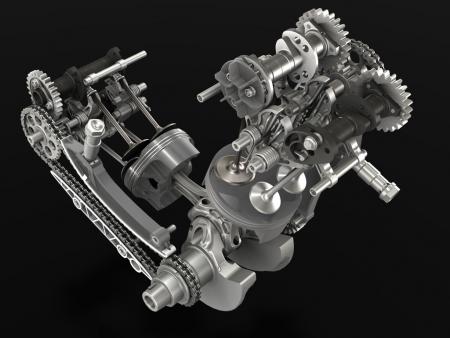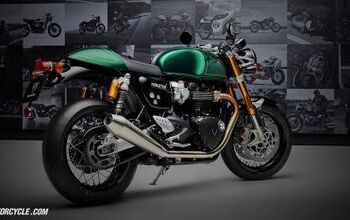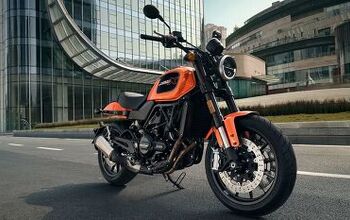2012 Ducati 1199 Panigale "Superquadro" Engine Details - Motorcycle.com
With so much hype surrounding Ducati’s 1199 Panigale – the successor to the 1198 superbike – we found it worthy to conjure up what we think the bike will be like in our 2012 Ducati 1199 Panigale Preview. We based much of that article around various sources, some of which are more reliable than others. And while much of what’s written about the 1199 and its architecture are simply educated speculations, yesterday Ducati released official information about the new game-changing powerplant, dubbed the “Superquadro” in anticipation of the model’s unveiling at EICMA next month.
It’s interesting to note that design sketches for the new machine began in 2008, the same year the much-heralded 1098R, which is essentially the same motorcycle Carlos Checa rode to this year’s World Superbike title, was released. It would seem logical then that the 1199 was at least a napkin sketch at the time of the 1098R’s unveiling. Having been at the world introduction of the 1098R, I can personally account for the buzz regarding it and its racing potential. To think that Ducati wasted no time drawing up its successor is a glimpse into the life cycles of design and how far forward manufacturers are thinking.
We stated in the preview story that the name stems from the engine’s highly oversquare bore and stroke dimensions. We guessed bore dimension correctly at 112mm, but were off just a tenth of a millimeter high in stroke dimension. In actuality it will be set at 60.8mm, for a bore/stroke ratio of 1.84:1. Such a short stroke length is needed in order for the engine to safely spin fast enough to produce the amount of power Ducati engineers felt would make it competitive against four-cylinder machines – a walloping 195 horses and 98 ft.-lbs (at the crankshaft), rates the factory.
Up Top
We were slightly off in regards to the engine’s redline, as we predicted the Superquadro would spin to at least 12,000 rpm. In reality the rev limiter is set to kick in at 11,500 rpm. Still, that’s a big number for a Twin. Speaking of big numbers, if Ducati’s claim of 195 crankshaft horsepower is correct, that would make the 1199 Panigale the most powerful production V-Twin ever, even putting it directly on par with its Japanese – and German – four-cylinder counterparts.
To handle such high stresses, intake and exhaust valves increase in size, 46.8mm (from 43.5mm) and 38.2mm (from 34.5mm), respectively. Both are also now titanium instead of steel (a method previously only used on “R” models) and are actuated by rocker arms coated in polymeric-like carbon (PLC), a process originally developed for the aerospace industry which greatly reduces friction (it’s a coating similar to the diamond-like coating seen on many high-performance fork stanchions).
An interesting trick Ducati has employed on the 1199 is the use of what they call an “auto-decompressor” to make the engine turn over with less effort from the starter. A flyweight at the end of each exhaust cam gear retracts at super-low speed to rotate a protrusion from the concentric side of the cam, thus creating just enough valve lift to relieve the pressure on the piston for easy startup. If you’ve ever had the pleasure of starting a Ducati, you’ve felt that anxiety just as you press the starter button as the engine struggles to turn over. The auto-decompressor alleviates that worry, and as a side benefit also allows the use of a much smaller (read: lighter) starter and battery.
Of course, actuating those valves is none other than the desmodromic mechanical system Ducati has sworn by for ages. Now, with the higher engine speeds precise valve movement is more important than ever, and Ducati feels as though it’s situations like this that emphasize the importance of mechanical valve actuation over valve springs. However, instead of belt-driven camshafts, Ducati is bucking with tradition and relying on a combination chain/gear setup. According to Ducati, this is the best way to precisely control timing of the sharp cam profiles, especially at high rpm. As a side bonus, this also helps extend the length of routine service intervals. Now valve adjustments are required every 15,000 miles, with oil changes at 7500 miles (racetrack usage will shorten those numbers). Don’t expect to see this tech trickle down to air-cooled Ducs, however – those models don’t rev high enough to warrant a switch.
Down Low
With such large pistons spinning at high rpm, the Superquadro units feature double-ribbed undercrowns for improved strength and reduced friction. The correct combination of air and fuel is fed to these massive cylinders via equally massive throttle bodies, measuring an equivalent diameter of 67.5mm. For perspective, the 1198’s measure 63.9mm! Each throttle body is actuated electronically via Ride-by-Wire technology, and feeds two injectors; one underneath the butterfly for better low-speed response and one positioned directly atop for outright power. The use of Ride-by-Wire technology also enables the implementation of ride modes and traction control, but Ducati is keeping those electrical secrets close to heart until the bike’s unveiling.
In our preview story earlier, we mentioned Bruno de Prato’s claim that Ducati was ditching the crankcase roller bearings that have been in use for over 20 years in favor of plain, or “shell” bearings currently employed by the Desmosedici RR engine in MotoGP. Turns out he was right. This enables larger diameter crank journals which makes for a more rigid and durable bottom end, suitable for the Superquadro’s power output. Bearings are force-fed oil from internal drillings within the main bearing pillars and that oil is sucked back into the sump via vacuum pump, technology taken straight from the MotoGP program. The pump is driven by the main oil-pump shaft and effectively maintains constant vacuum in the crankcase area below the pistons, reducing pressure during the cylinder’s down strokes and controlling the engine’s “breathing.”
And while we’re on the subject of breathing, Ducati was able to achieve this power while still meeting ever-stringent emission requirements. One of the methods of achieving this is the introduction of a secondary air system that helps complete the combustion of unburned hydrocarbons. Through the use of lambda and throttle position sensors, the ECU detects specific conditions and, if needed, opens a valve in the main airbox to a reed valve in each cylinder head. Ultimately, this fresh air is routed to the exhaust valve at its hottest point, enhancing the burn environment and combusting any unburned fuel.
Attention wasn’t just given to the engine, however. An all-new gearbox features stronger, larger-diameter gears to cope with the increase in power. A bigger shock is Ducati’s switch to a “wet” oil-bath clutch after years of sticking with the dry clutch design. The design is based closely on the Multistrada and Diavel units and features a slipper function to prevent wheel-hop under hard braking or quick downshifting.
Too Slow. Not.
Apart from the above information, here are some other interesting tidbits about the Superquadro. First seen on the the 1200 Multistrada and new 848 Streetfighter, Ducati utilized an 11-degree valve overlap to maximize torque output at the expense of top-end power. With the Superquadro, however, a 45-degree overlap is used to squeeze out every last bit of power.
Overall, the dimensions of the Superquadro engine are more compact than the 1198, though it’s slightly taller due to the deeper oil sump needed for heavy braking. Direct weight comparisons between old and new are harder to measure, as the new powerplant is reinforced in order to handle the increased demands of being the main stressed member of the monocoque chassis. Ducati insists on measuring the overall weight of the complete motorcycle, which it claims will be lighter than the outgoing 1198.
Despite the MotoGP team experimenting with seamless shift technology, Ducati denies that this was even considered in the design of the 1199 Panigale. The company also denies even considering the use of a V-Four engine configuration like rival Aprilia and the RSV4 Factory. According to Claudio Domenicali, Ducati General Manager, “We still consider the Twin the best option when you come to offer the ‘Ducati feeling,’ which is strongly based on light weight and torque.”
And to answer a question many are surely wondering, Ducati denied the prospect of the Superquadro engine being used on future models. Seeing as how it serves as the main stressed member of the frame, that would mean future Ducatis would also need to be completely redesigned to support a monocoque chassis. Possible? Sure. Likely? Probably not. But when it comes to the folks in Borgo Panigale, one learns to never say never.
As we mentioned in the beginning, complete details about the rest of the 1199 Panigale will be revealed at the EICMA show in Milan next month.
Related Reading
2012 Ducati 1199 Panigale Preview
2012 Ducati 1199 Panigale Spy Photos
Ducati 1199 Panigale Forum
More by Troy Siahaan



































Comments
Join the conversation